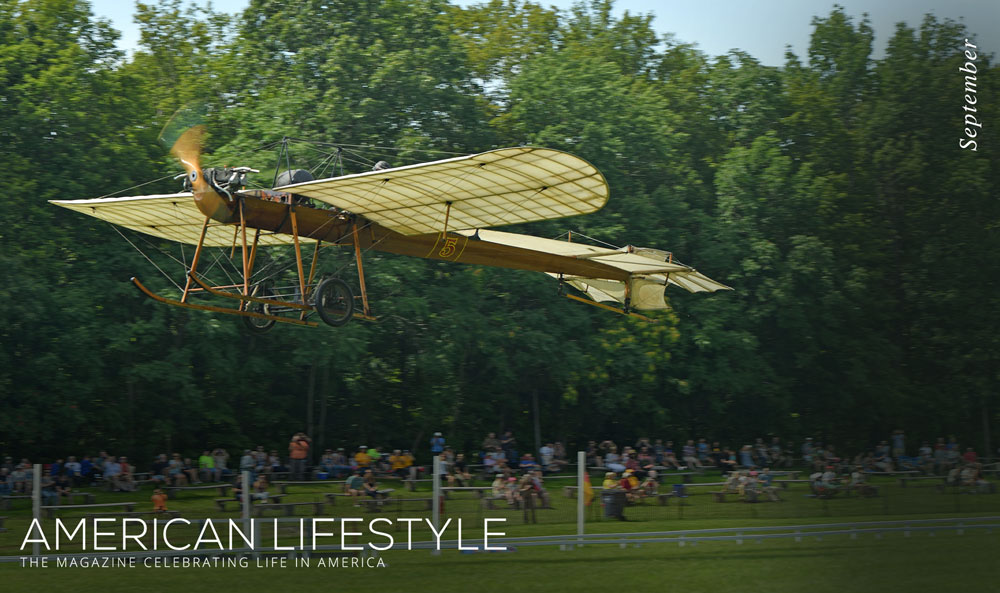Dear Friends,
A new season is a great time to get out and explore exciting destinations and enjoy time with your loved ones, and this issue of American Lifestyle is full of ideas to help. It includes a look at seven historic covered bridges, a deep dive into the benefits of public libraries, two comforting Italian dishes, and an exploration of a Hudson Valley aviation museum and air show.
Covered bridges have long played an important role in connecting communities across America, but unfortunately, many of these structures have been lost to time. The enclosed article examines seven of these amazing bridges that are still standing strong, looking at what makes each one unique and worth a visit this fall.
Public libraries are among the most essential institutions in communities across the country, providing many important services. Inside, you’ll discover more about the great impact public libraries have on people of all ages.
Italian food makes for a delicious weekday dinner option as this type of cuisine is often filling and packed with flavor. This issue offers two delicious recipes for rigatoni with fiery roast tomatoes and ricotta and pistachio panna cotta that you and your loved ones are sure to love.
In New York’s Hudson Valley, the Old Rhinebeck Aerodrome is filled with vintage planes and features a thrilling air show each summer and fall. Learn what makes it a must-see for aviation enthusiasts and novices alike.
Here’s to an exciting season spent exploring new sights! As always, it’s a pleasure to send you this magazine
Kind Regards,
Anne Hitch
The Edgewater Group of SC, LLC
Covered bridges are not merely impressive structures—they are also time capsules that embody a distinct piece of American history and craftsmanship. Often nestled in picturesque locales, they evoke a sense of nostalgia and charm, captivating travelers with their rustic allure. Approximately 14,000 of these structures once stood across the United States, but only 500 to 600 remain today, dotting the landscape from the rolling hills in the east to the sun-kissed shores of the west. Here’s a closer look at seven of the most prominent, each with its own story to tell.
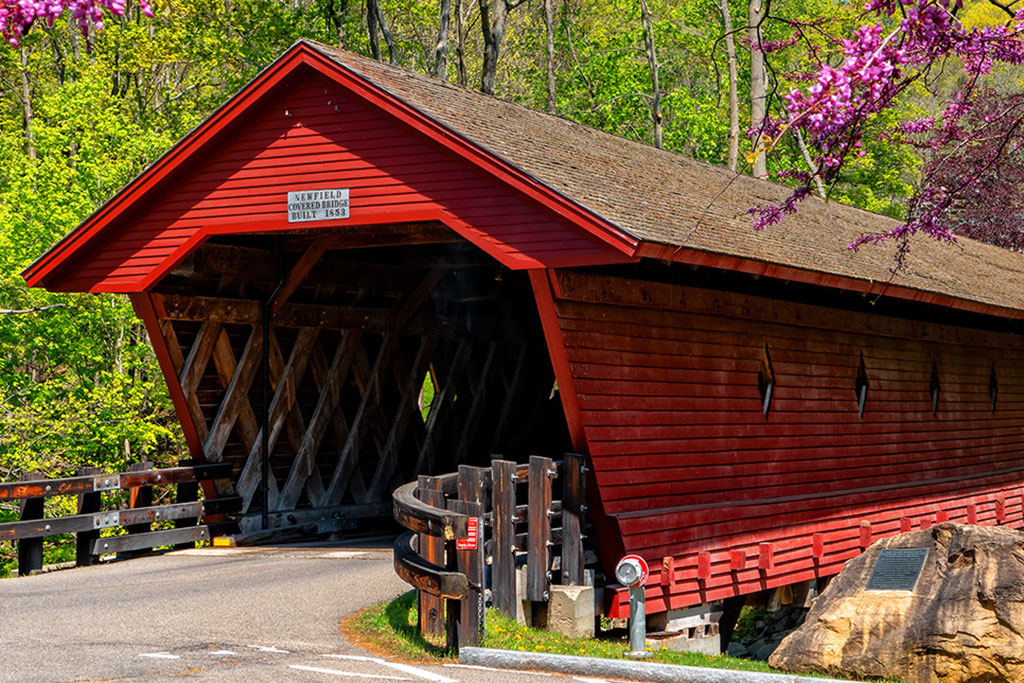
Built in 1853, this landmark near Ithaca is the oldest functional covered bridge in the state. Crossing over Cayuga Creek, it originally cost an estimated $800 to build and has since undergone a complete restoration, which, among other improvements, raised it one foot and replaced the trunnels (wooden pegs used to connect pieces of wood) to strengthen it. Backdropped against stunning foliage, Newfield’s weathered planks and red facade are certainly a sight to behold.
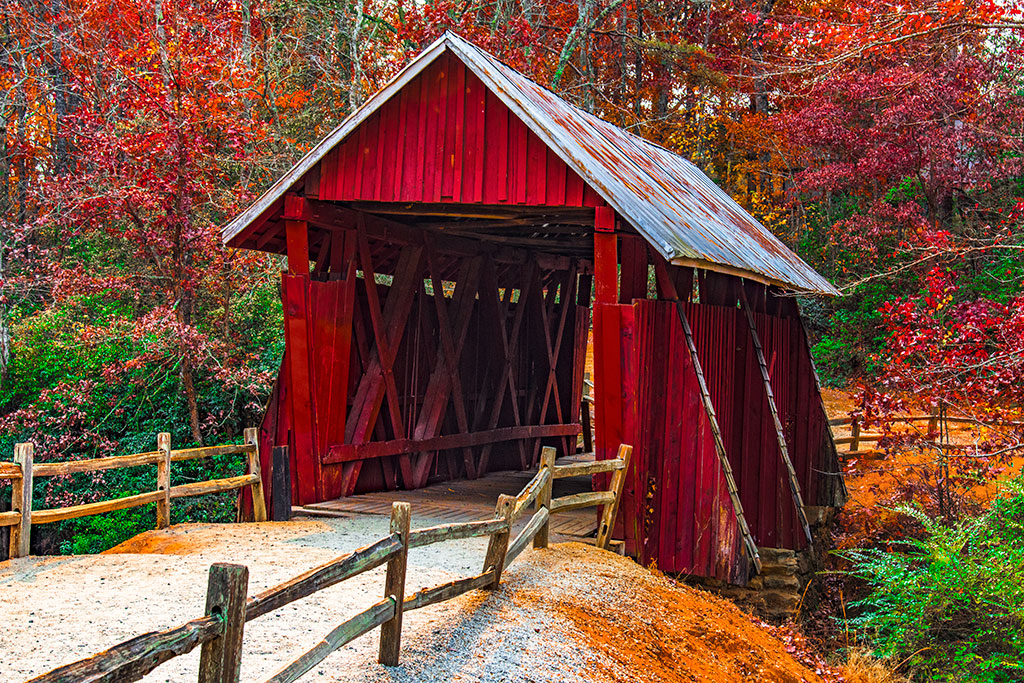
Greenville County in northern South Carolina used to be home to four covered bridges, but only one remains today—in fact, Campbell’s Covered Bridge is the last one left in the entire state. Spanning the tranquil waters of Beaverdam Creek, it offers a beautiful gateway to the rural landscape, giving travelers who pass through an up close look at the giant X-shaped support beams emblematic of the Howe truss bridge design. With its historic markers and pastoral tranquility, Campbell’s is certainly a beloved symbol of the Palmetto State’s enduring heritage.
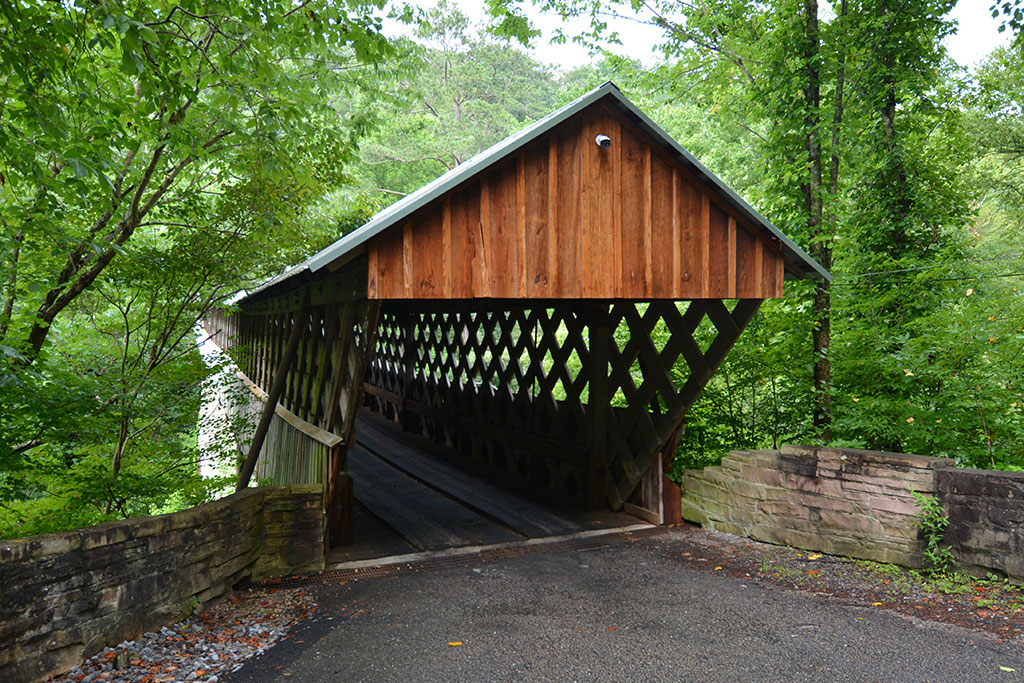
Measuring 70 feet above the water, this Alabama bridge is one of the highest across a waterway in the United States. Though it closed to automobiles in 2022, pedestrians are still more than welcome to meander down its lengthy stretch; a walk across its creaking planks is guaranteed to bring beautiful sights that photographers and nature lovers alike will appreciate. Better yet, Horton Mill is one of three covered bridges in Blount County, giving you a prime opportunity to explore multiple historic landmarks in the span of a day.

In 1897, builder Charles Horton obtained a construction patent for a design that minimized the need for rivets and bolts, allowing bridges to be constructed without expensive machinery. One example of his revolutionary method is nestled in Amnicon Falls State Park in northwest Wisconsin, less than thirty minutes from the coast of Lake Superior. It was originally built in another location and without a roof, only obtaining a covering after being moved to the park in 1939. Today, Horton continues to be a cherished landmark not only for its architectural significance but also for its scenic beauty, giving visitors stunning views of waterfalls along with potential glimpses of beavers, otters, and other wildlife bustling below.
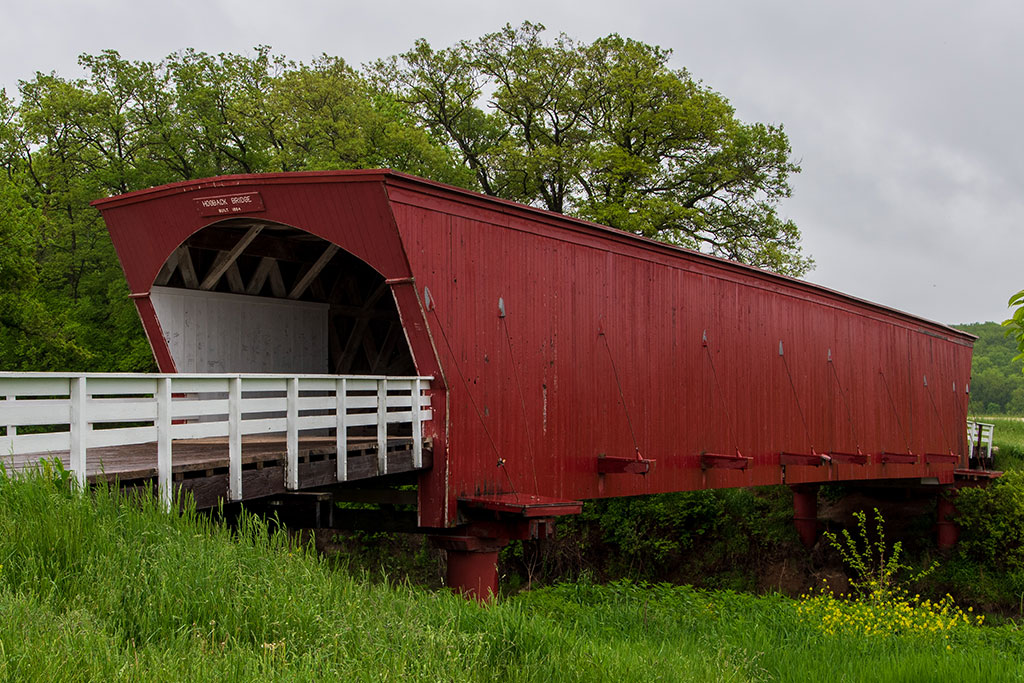
Iowa’s Madison County is home to all the state’s remaining covered bridges, with the crown jewel arguably being Hogback in Winterset. Named after a nearby limestone ridge, the bridge was constructed using a Town lattice truss design, which involves crossing wooden planks and beams diagonally. Over the years, it has faced an array of challenges, including floods, fires, collisions, and neglect, and still it has outlasted the hundred or so other covered bridges that once stood in Iowa. It was restored in 1992 for a total of $118,810 to help preserve it and ensure that travelers can continue to enjoy it for generations to come.
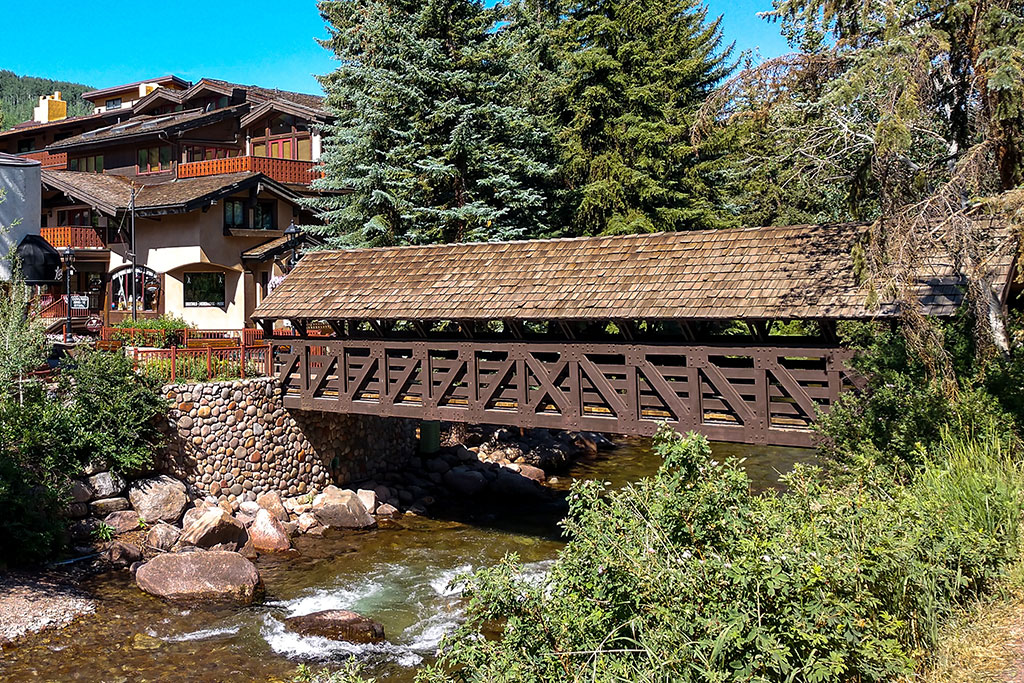
Tucked within the majestic beauty of Colorado’s Rocky Mountains, this covered bridge spans the pristine waters of Gore Creek, lending a scenic entrance into the charming Vail Village. It was first constructed uncovered, only gaining a roof in 1965 when Vermont natives John and Cissy Dobson moved to town and offered to cover half the cost. With its picturesque surroundings, the covered bridge quickly added extra charm and whimsy to the village and became an emblem of the region’s natural splendor, whether framed by vibrant autumn foliage or blanketed in a layer of winter snow.
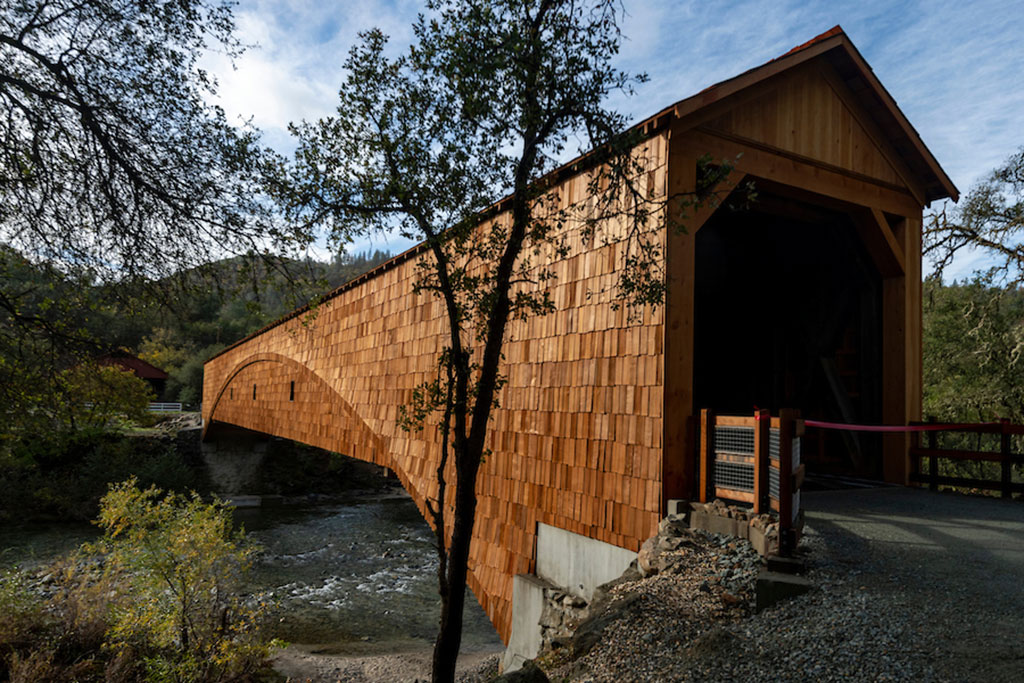
What sets this bridge apart is not just its enchanting setting but also its significance as the longest single-span covered bridge in the United States, standing at 233 feet long. Originally built in 1862, it is an iconic attraction within the South Yuba River State Park in Nevada County, California. It was closed in 2011 after a survey revealed that a flood had caused significant damage to the structure, but with the help of the Save Our Bridge Campaign Committee, it was restored beginning in 2019 and reopened to the public in 2021. The beloved landmark continues to draw visitors to the park as they seek to bask in its timeless charm.
Covered bridges are a testament to a bygone era, a time of exceptional craftsmanship and ingenuity. While their numbers have dwindled, the remaining ones serve as open-air museums, bringing pockets of charm and nostalgia to travelers across the nation.
In an age when information is readily available at our fingertips, public libraries may seem to have lost some of their luster. However, these crucial institutions—numbering approximately 9,000 across America—are just as important as ever. After all, they not only open gateways to knowledge in the form of reading but also serve as foundations of culture and community engagement. And though the layouts and contents of their shelves may vary, every single library around the country, whether large or small, lends support to its citizens in a surprising number of ways.

Of chief importance, public libraries create knowledge equity, granting everyone free access to information, the arts, and entertainment regardless of socioeconomic status. This can lend a lifeline to those who may otherwise experience obstacles to pursuing learning or reaching their educational goals. Libraries offer everything from new bestsellers to classic fiction to reference materials, and many even provide free internet access along with computers for staying productive or browsing casually.
While some institutions may charge for services such as printing and require proof of residency to check out materials, their facilities are generally free. So whether you’re looking to settle into a reading nook with the latest trending novel or catch up on local news, you can relax or work for hours without needing to pay a dime.

Amid the dominance of digital entertainment and social media, public libraries foster a love for books and learning through story hours, reading programs, and educational workshops. These services are particularly valuable for children, who benefit greatly from discovering reading at an early age. The Child Mind Institute reports that reading helps kids develop not just their cognitive skills but also their critical thinking, ability to grasp new subjects, and empathy and emotional awareness. By providing free and broad access to reading materials that are geared toward different developmental stages, libraries enable parents to support their children’s reading skills, better setting them up for a lifetime of success.

Your education doesn’t have to end with the conclusion of your school days; libraries’ various tools help adults pursue lifelong learning, whether for recreational or career purposes. In addition to nonfiction and fiction reading materials, they often have resources for job seekers, professional-skills training, and even household management services such as budgeting workshops and health-care classes. For example, Philadelphia’s many libraries hold complimentary typing and resume-building courses, among many others. Meanwhile, the small Idaho town of Rexburg offers online guides to topics like nutrition and purchasing insurance, which locals can access from a library computer or the comfort of their homes.
In this way, public libraries provide accessible platforms for individuals to stay informed about and adapt to the evolving demands of the modern world. As a result, they can be empowered to thrive in their personal and professional lives, in turn fostering their own well-being and potentially boosting local economic growth.

Beyond their role as repositories of knowledge, public libraries serve as vibrant cultural institutions that enable visitors to engage in many forms of creative enrichment, such as art exhibitions, discussions with authors, and workshop classes. The Cargill Gallery inside Minneapolis Central Library, for one, features diverse exhibits that spotlight local talent, while the Denver Public Library gives free passes to numerous historic and artistic locales around town. As a benchmark example of cultural enhancement, look to Washington, DC’s Library of Congress, which is the world’s largest library with not only millions of reading materials but also countless films, music records, and other fascinating artifacts to enjoy. Once again, libraries offer all this for free, inviting young and old alike to stimulate their creativity and indulge in the eye-opening power of the arts.
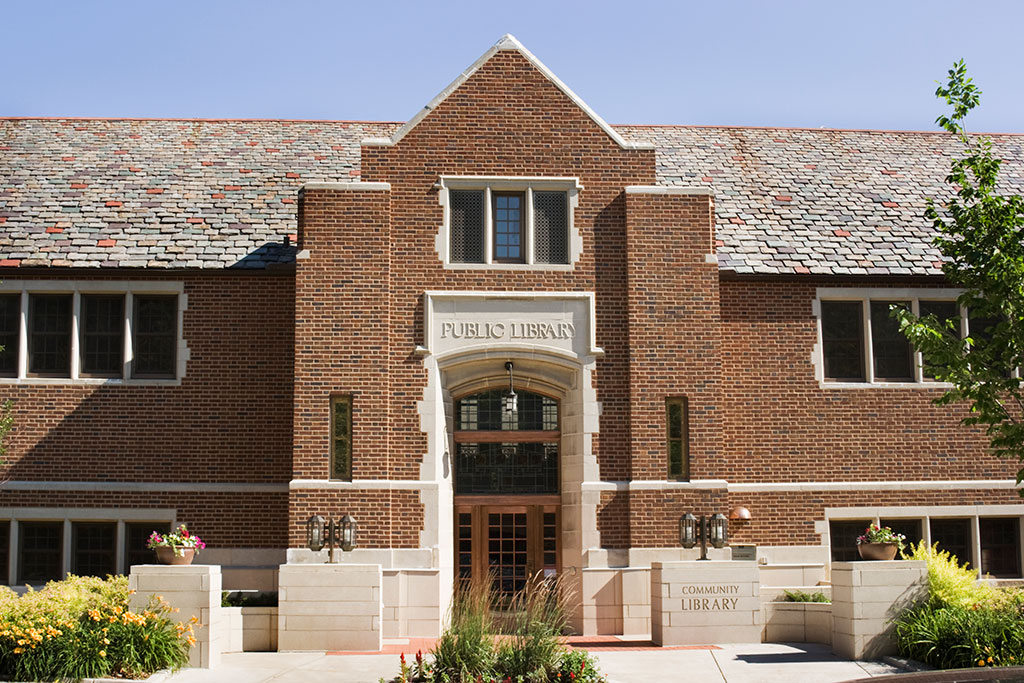
The artistic value of libraries isn’t only contained within them. In fact, some act as local monuments that dignify their communities, imbue them with historical significance, and attract tourists with their architectural splendor. For example, the Juneau Memorial Library flew Alaska’s first forty-nine-state American flag after achieving statehood in 1959—and continues to do so today. Delaware’s Wilmington Public Library, another historic setting, serves as an impressive representation of eighteenth-century neoclassical architecture. And the small community of McAllen, Texas, gained nationwide attention when it converted an unsightly abandoned Walmart into an enormous public library. These and other institutions bring immense pride to their patrons, both for the beauty of their facades and the indispensable roles they play in their communities.
Regarding the enduring value of libraries, T. S. Eliot may have put it best: “The very existence of libraries affords the best evidence that we may yet have hope for the future of man.” It may be easy to underestimate the value of these often quaint and quiet institutions, but they hold great significance for communities throughout America. Whether you’re a regular at your local library or have yet to take advantage of its numerous services, it may just surprise you with how much it has to offer beyond books.
Italian food has ranked at or near the top of Americans’ favorite fares for decades, and we embrace it even more during cool autumn months. Treat yourself and your loved ones this season with two recipes from the Italian Coastal cookbook—they’ll transport you to the bel paese (beautiful country) without you ever having to leave your home.
Heat up chilly fall nights with this pasta recipe, which is bursting with chili-infused cherry tomatoes mixed with two cheeses.
The taste and color of pistachios take center stage in this version of the classic custard-like dessert.
Excerpted from Italian Coastal by Amber Guinness. © Thames & Hudson Australia 2024. Text © Amber Guinness. Reprinted by permission of Thames & Hudson Inc. Recipe photo credit: © Saghar Setareh
written by amber guinness
photos by saghar setareh
This pasta is inspired by the volcanic island of Stromboli in the Aeolian Islands and its fiery unpredictable nature. I love this dish as it delivers on flavor and deliciousness with minimal effort. All that’s required is putting a dish of tomatoes in the oven, followed by the ricotta, cooking the pasta, and uniting the two in the baking dish. I like to think of it as an ode to Stromboli through spice and domed ricotta.

Serves 5
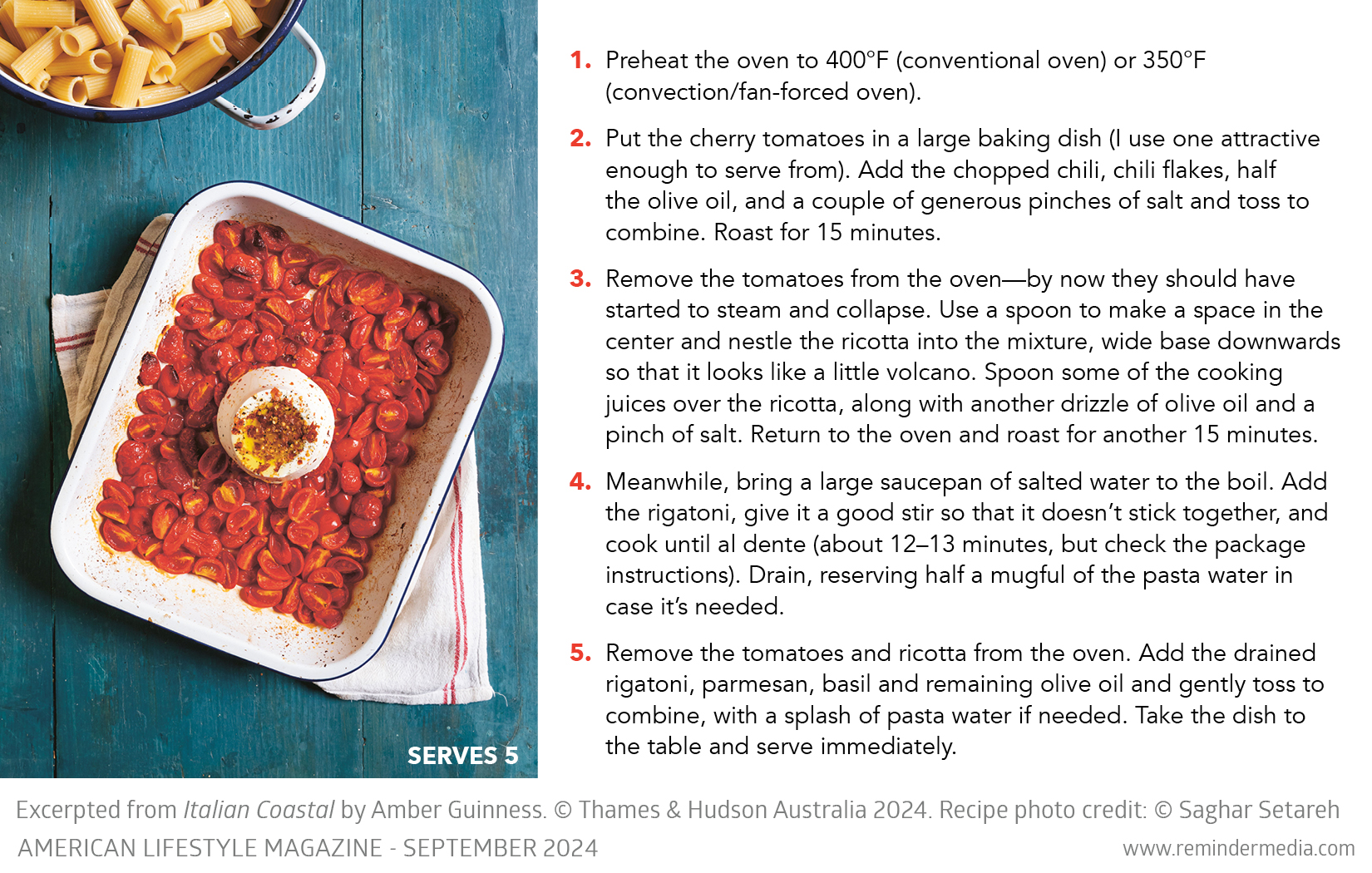




written by amber guinness
photos by saghar setareh
Mixing pistachio cream with panna cotta is an indulgent twist on a classic, bringing a nutty sweetness to the cream as well as acting as a second setting agent, meaning you need less gelatin. I serve these in cocktail glasses and never turn them out, mainly because their green color doesn’t look as attractive domed on a plate as it does sitting in a glass topped with chopped pistachios or a few fresh raspberries.

Serves 4





New York’s Hudson Valley is well-known for its orchards and stunning nature views, but nestled in the heart of it also lies a true aviation wonder: the Old Rhinebeck Aerodrome. At this private airport, you can watch classic airplanes soar over the scenic surroundings and tour a museum filled with vintage gliders, planes, automobiles, and artillery. Take a weekend trip to this beautiful location, and you’ll get an experience you won’t soon forget.
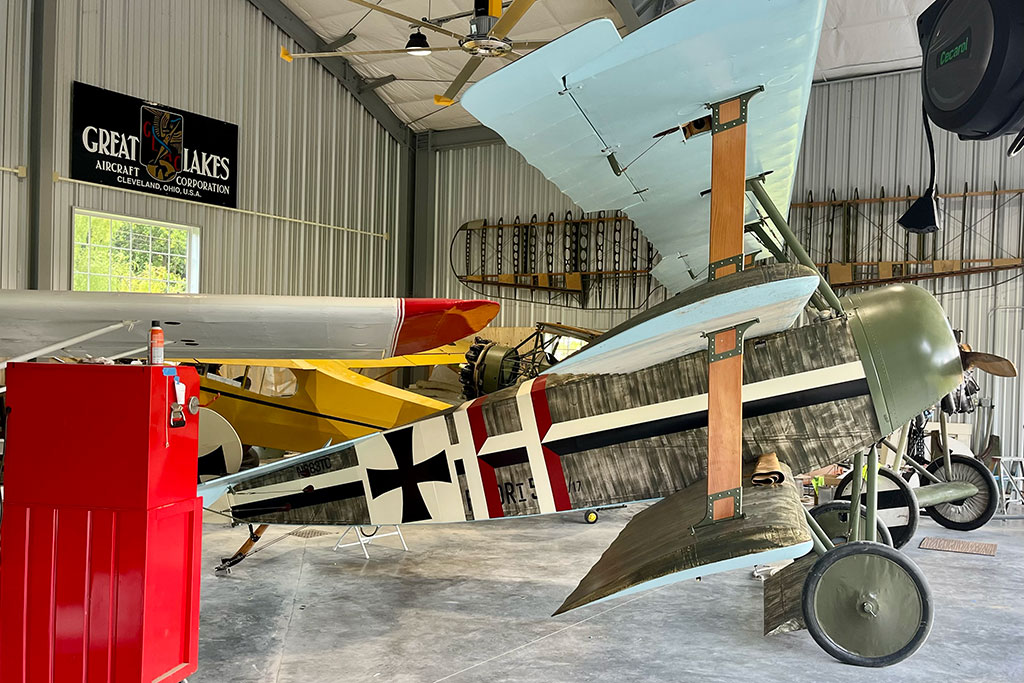
This family-friendly venue, consistently voted as one of the best attractions in the Hudson Valley, is the creation of Cole Palen, who grew up watching airplanes from a local airport fly over his family’s farm in Poughkeepsie, New York. After serving in the infantry in World War II, he took flight and mechanics training at Roosevelt Field—the same airfield where aviator Charles Lindbergh launched his famous nonstop, solo transatlantic flight in 1927. Palen later bought six aircraft from this historic airport during its closeout auction.
In 1951, Palen purchased a tract of land and began preparing a grass runway and hangars for his airplanes, eventually opening the airport in 1958. Over the years, he built and restored many vintage airplanes and replicas with the help of his crew, who continued his work after his death in 1993. There are now more than eighty aircraft at the Old Rhinebeck Aerodrome, approximately twenty of which are in flying condition.

To get the most out of your weekend visit, plan to arrive when the gates open at 10:00 a.m. so you’ll have plenty of time to explore the grounds before the preshow begins at 2:00 p.m. Get a glimpse of the airplanes being readied for the show on the field, and peruse the classic and reproduction aircraft, motorcycles, and cars housed in the museum’s three airplane hangars. If you dare, consider buying a ticket for a fifteen-minute, open cockpit ride in a 1929 New Standard D-25 over the Hudson Valley. The rides are first come, first served, and fill up quickly; they are also available weekdays during the last week of October as well as in May through mid-June.
When you’re ready for the air show, grab a snack at the refreshment stand and settle on the wooden bleachers or in your own chair on the grass nearby. If you attend on Saturday, you’ll be treated to a performance featuring planes from the 1920s and 1930s along with a preview of Sunday’s spectacle. One star you’ll get to delight in is a meticulously constructed replica of Lindbergh’s Spirit of St. Louis. Begun by Palen, the plane was later completed by friend Ken Cassens and a team of volunteers in Palen’s honor after his death.
Meanwhile, Sunday’s action-packed aerial display includes a World War I-style dogfight, antique cars and a tank, and a dramatic storyline the whole family can enjoy. You might just find yourself rooting enthusiastically against the fictitious “Black Baron” as he flies a replica of the Fokker Dr.I triplane—the aircraft piloted by deadly German ace pilots Manfred von Richthofen and Werner Voss during the First World War.
Before purchasing your air show tickets, be sure to check the weather report since certain conditions can result in show cancellations. You’ll also want to schedule your visit for before October 20—otherwise, you’ll have to wait until mid-June of next year to take in a show.
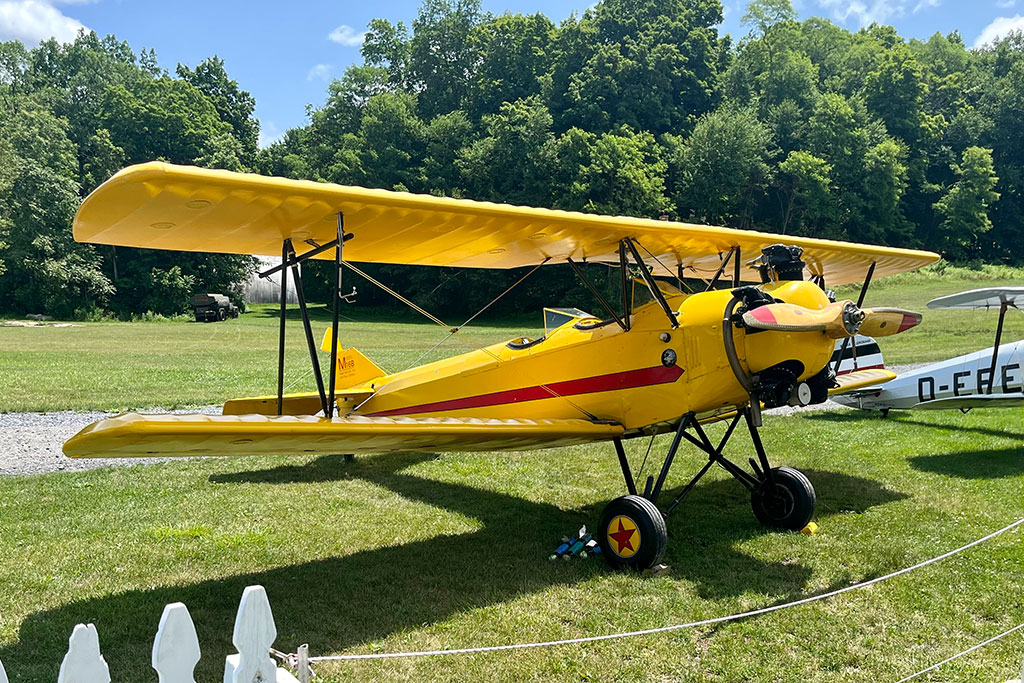
Touring the museum and grounds and watching the spectacular aviation display makes for a fulfilling experience on its own, but if you’d like to take full advantage of your sojourn to the Hudson Valley, you can certainly make a whole weekend of it. For example, you could plan to stay at any of the charming bed and breakfasts nearby, such as the Grand Dutchess, a historic Victorian mansion that truly takes you back in time. After coffee or tea in the parlor the next morning, consider walking on the Hudson River Skywalk, a pedestrian bridge over the waterway where you can take in the beautiful Catskill Mountains. Another interesting option is to visit the Franklin D. Roosevelt Presidential Library and Museum in Hyde Park for its collection of photographs and presidential memorabilia from the Great Depression era through World War II.
Whether you want to brush up on history, marvel at pilots’ daring exploits, or simply gaze at the stunning scenery of the Hudson Valley, you’ll find the Old Rhinebeck Aerodrome to be more than worth the trip.
For more info, visit oldrhinebeck.org
